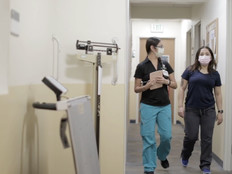Cloud
Connected Care: Providence Enhances Patient Care with the Cloud
Providence turned to data analytics in the cloud to better manage the rise in patients during a COVID-19 surge in 2020. The health system’s clinical analytics team developed data analytics tools that gave its leaders real-time information on patient volume, hospital staffing levels and the supply of ventilators and personal protective equipment throughout its 52 hospitals.
The organization also ran predictive analytics through Microsoft Azure to accurately forecast which hospitals would see spikes in COVID-19 cases, allowing Providence to staff up and move ventilators and PPE to the locations that needed them most. The cloud also aided the health system in analyzing whether patients without COVID-19 were put at risk by visiting the hospital for emergencies.
“Early on, we found that there had been a big decline in patients presenting to our hospital for acute reasons in our emergency departments, for events such as heart attacks, strokes and gastrointestinal bleeds. We were concerned that patients were afraid to come to our EDs because they were worried they were going to pick up COVID-19 at our hospital,” says Dr. Ari Robicsek, chief medical analytics officer at Providence. “We did an analysis where we found that even if a patient without COVID-19 came to the ED and spent hours there alongside another patient who had COVID-19, the first patient who didn’t have COVID-19 wasn’t any more likely to pick it up than anybody else who lived in the same community.
The bottom line was that our emergency departments were safe, and patients shouldn’t delay. We were able to publish that in literature early on.”
The cloud also has helped Providence beyond the pandemic to enable clinicians with better diagnostic tools.
“One of the projects that we’re working on right now is Caregiver Accessible Knowledge Engineering, or CAKE. Many clinicians suffer burnout, and often they point to the electronic medical record as a source of burnout. They’re constantly pouring data into the electronic medical record, but they don’t get that much benefit from their extensive use of it,” says Robicsek. “The idea of CAKE is to allow clinicians to configure their experience in the EMR, especially by giving them the ability to write their own, ‘if this, then that,’ rules. For example, a clinician using this tool can say, ‘If I see a patient who is high risk for disease X, then remind me about that and remind me that I ought to be getting a particular test on that patient.’”
While these calculations may be simple, many genetic and demographic factors often come into play, requiring cloud computations to support the analysis.
“That’s a really neat example of how cloud will enable better decision-making at the bedside,” says Robicsek.
The health system uses Azure Data Lake Storage Gen2 for storage, Azure Databricks for analytics and machine learning, and Power BI to produce real-time reports on dashboards, which allow frontline caregivers to make critical decisions during the pandemic.
While dashboard use has waxed and waned depending on infection rates, real-time data streaming is just one use of the new cloud data platform. Providence also plans to migrate some of its Epic instances to the cloud this year in addition to moving images to the cloud.
Participants
Dr. Ari Robicsek, Chief Medical Analytics Officer, Providence
Tabitha Lieberman, Senior Vice President of Clinical and Revenue Cycle Applications, Providence
Video Highlights
- Providence tried performing data analytics with its data warehouse, but the servers couldn’t handle both the compute-intensive task and daily data processing needs consistently.
- In mid-2019, the health system turned to Microsoft Azure cloud services to modernize its IT infrastructure and run its newly developed data analytics tools.
- The cloud has helped clinicians at Providence improve diagnostics with data analytics while making workflows more efficient.





